This article was originally published on amigaportal.cz in December 2024. In this text are minor corrections.
Even though the Sam460ex has been with us for almost fifteen years, it has been somewhat inconspicuous in the AmigaNG world. You will find almost no blog or review about it. Maybe just a few videos on youtube. And yet this computer is special in several ways. So since I have had the latest version of the Sam460LE since last year, I'll introduce it a bit.
Sam460ex ( HW: 2010, AmigaOS 4.1 u2: 2011, MorphOS 3.8: 2015)

1. History
In 2008 when ACube was the only company producing AmigaOS compatible computers, I was enjoying my great and powerful Pegasos 2 with MorphOS and the problems in the AmigaOS scene were beyond me.
Nevertheless, something very, very important happened at that time - Hans de Ruyter started developing a RadeonHD driver for AmigaOS 4. And although development originally started on the AmigaOne XE with the X1300 PCI graphics card, it was this driver that opened the way for Amigas to enter the era of modern PCI-express cards.

And the very first computer for AmigaOS with PCI-express bus was Sam460ex. ACube announced its development in April 2010, and it was unveiled at the Vintage Computer Festival in Bletchley Park on 19 June that year. From January 2011, the Sam460ex shipped with AmigaOS 4.1 Update 2 and the RadeonHD driver. This put the Sam460ex less than a year ahead of the better known and more powerful AmigaOne X1000.
MorphOS then added support for Sam460ex in 2015 in version 3.8.
Sam460 holds another record - it has been in production in several versions for more than twelve years. Which is the most among NG Amigas and even longer than all classic Amiga models from A1000 to A4000T. And this is what the different modifications look like:
Sam460ex ( 2010 ): clocked at 1.066 GHz or 1.15 GHz, motherboard had a Flex-ATX format ( 3 rear slots ) and contained the most components: an SM502 audio/video chip, a video connector and 1x SATA II connector.
Sam460ex - Lite ( 2011 ): 1.0 Ghz, comes with 512 MB DDR2.
Sam460cr ( 2014 ): cr = cost reduced, 1.0 and 1.1 GHz, components which was used minimally were removed - the SM502 chip and the video and SATA II connectors.
Sam460LE ( 2022 ): LE = Limited Edition, 1.1 GHz and 1.14 Ghz, again, it does not include the SM502 chip or SATA and video connectors, the motherboard has been redesigned to the components available after Covid, the board format has been changed to Micro-ATX ( 4 rear slots ) to make it easier to fit dual-slot graphics cards.
Sam460ex or Sam460cr completed with cards in custom case using the name AmigaOne 500.
2. Specifications of Sam460LE
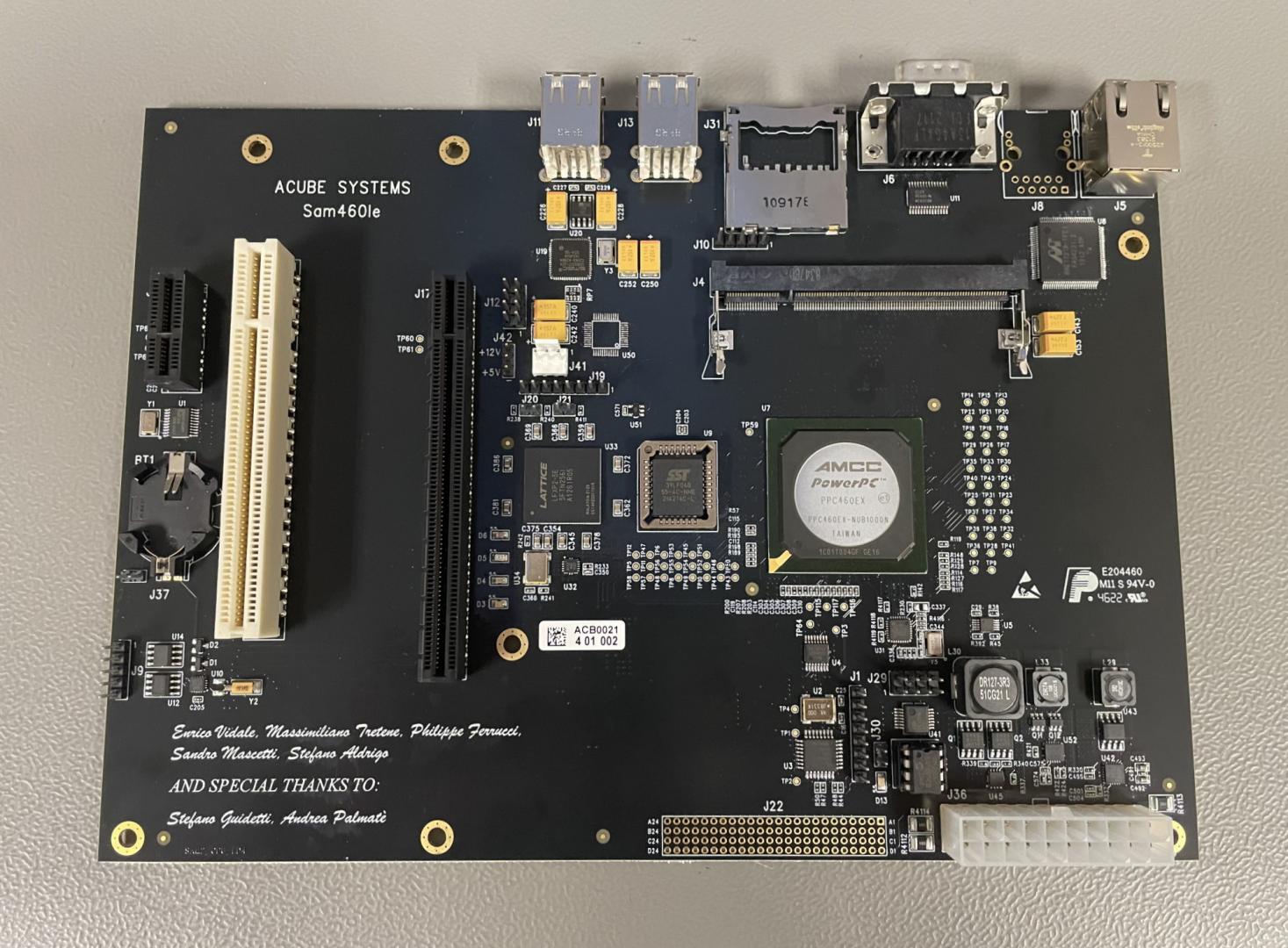
Motherboard: micro-ATX
CPU: AMCC460ex, 1.1 or 1.14 GHz, 256 KB L2 cache ( Power ISA v.2.03, Book III-E )
Coprocessor: Lattice XP2
RAM: up to 2 GB DDR2, 400 MHz
GPU: not built-in
HDD controller: not built-in
Ethernet: 1 GbE
USB: 4x external + 2x internal, 2.0
Expansion slots:
1x PCIe v 1.1, x4 lines ( x16 connector ), usually equipped with a graphics card
1x PCIe v 1.1, x1 line, usually equipped with a sound card
1x PCI v 2.3, 66 MHz, 32 bit, usually equipped with SATA I controller SiI 3x1x
3. My impressions
Like previous NG Amigas from ACube ( Sam440ep and Sam440ep-flex ), the Sam460 has a relatively weak CPU for today without VMX. However, for AmigaOS or MorphOS it is not that weak, the raw performance in MIPS of the AMCC 460ex / 1.14 GHz CPU corresponds approximately to a G3 or G4 / 1 GHz.
Sam460 is based on the AMCC 460ex SoC. While this processor contains the same core ( Powerpc440 ) as the AMCC 440ep processor used in the Sam 440ep(-flex), it has an additional 256 KB L2 cache, contains newer peripherals ( DDR2, PCI v2.3, PCIe, SATA II, GbE, USB 2.0 ) and can be clocked at higher frequencies.
The coherence of the L2 cache in the processor is only partially secured by hardware, in some cases it is necessary to use a software solution, which can lead to slowdowns.

As you can see in the schematic, the Sam460ex also has a SATA 2 connector and an SM502 audio/video chip. However, we can only connect one device to SATA2 and at the same time we will not be able to use the PCIe x1 connector. And the SM502 chip, even though it has 2D acceleration, is quite underpowered for desktop. It is a chip with 64 MB video RAM and 1280 x 1024 resolution used for server graphics and industrial ( embedded ) devices. For our purposes, only the AC97 audio is usable.
The Sam460cr/LE versions do not include the SATA 2 connector or the SM502 chip. Usually the PCI connector is equipped with a SATA controller, a PCIe x1 sound card and a PCIe x4 graphics card. So even though the Sam460 has three PCI/PCIe connectors, it is not very expandable at first glance.
Sam460 also has an SD card reader. It is connected as a USB 2.0 device. The SD card can be used in place of a hard drive, however due to the lower speed and limited life of SD cards I do not recommend this. The card can serve well for Linux kernel, MorphOS Hyperbootloader or AmigaOS /Kickstart in case you want to have multiple operating systems at the same time.
Otherwise, ACube supplies an SD card containing an installation DVD with AmigaOS4.1fe and instructions on how to make a bootable SD card from any .iso image. So you don't need any optical drive when installing systems.
Unlike previous versions, the Sam460LE has an SD card located on the back side between the serial port and USB ports, so the card is accessible without opening the computer case. I definitely have to commend this feature.
4. Three operating systems
The great thing is that the Sam460 is one of only three computers that can run AmigaOS, MorphOS and Linux natively ( only the Pegasos 2, Sam460ex/cr/le and AmigaOne X5000 can do it ). In practical implementation, however, you'll run into a few little things that make this a bit difficult. Those who have read the article AmigaNG - HW compatibility with AmigaOS, MorphOS and Linux ( https://www.amigaportal.cz/node/166748 ) already know what this is.
The biggest little thing is of course the graphics card ( maybe I'll mention the other smaller little things in a separate article ). So it's important to first decide what system we want to use as our primary system and choose a card accordingly. Reasonable options for choosing a graphics card today in 2024 are as follows:
4.1 AmigaOS ( W3DNova, VA )

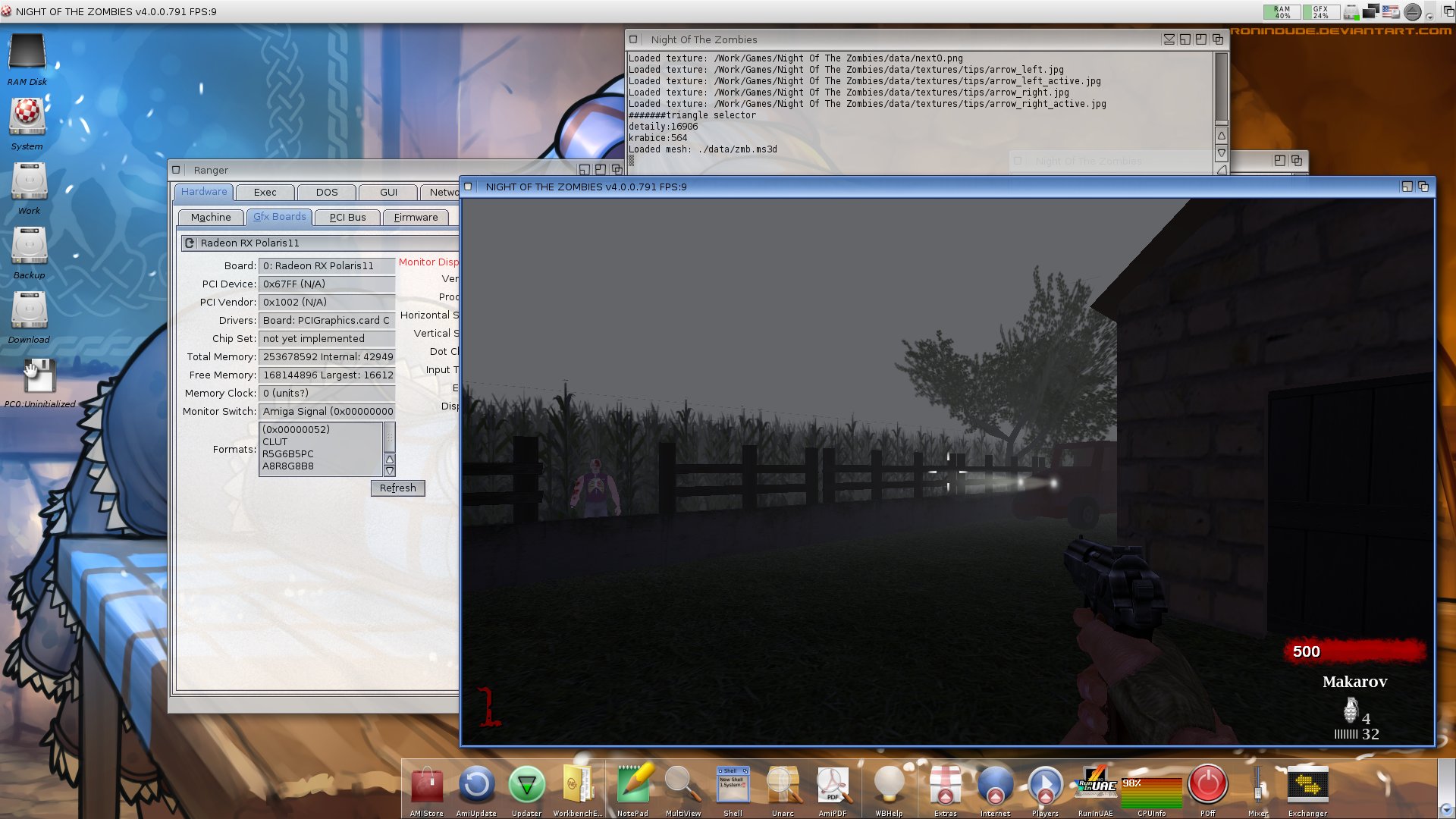
Polaris cards are the best choice for AmigaOS. They are compatible with Warp3D Nova and va.library.
Since the Sam460 doesn't have such a powerful CPU, a VA compatible card will be appreciated ( VA = Video Acceleration ). You can play FullHD videos with the H.264 codec just fine. Polaris cards also include a decoder for H.265 / HEVC videos, so it's possible they will be in a new driver version in the future.
With U-Boot 2015.b we don't have graphical output from the firmware at boot, but that doesn't matter at all because neither MorphOS nor Linux support these cards, so you don't need any bootmenu. U-Boot 2015.c from May 2024 already supports firmware graphical output from RX cards.
4.2 AmigaOS ( W3DNova, VA ) + linux ( drmfb )

These cards are compatible with both Warp3D Nova and va.library, but are less powerful than Polaris cards. H.264 HD ( 720p ) videos will play on DVPlayer with about 12% CPU load. These cards are not sufficient for FullHD and do not include an H.265 decoder.
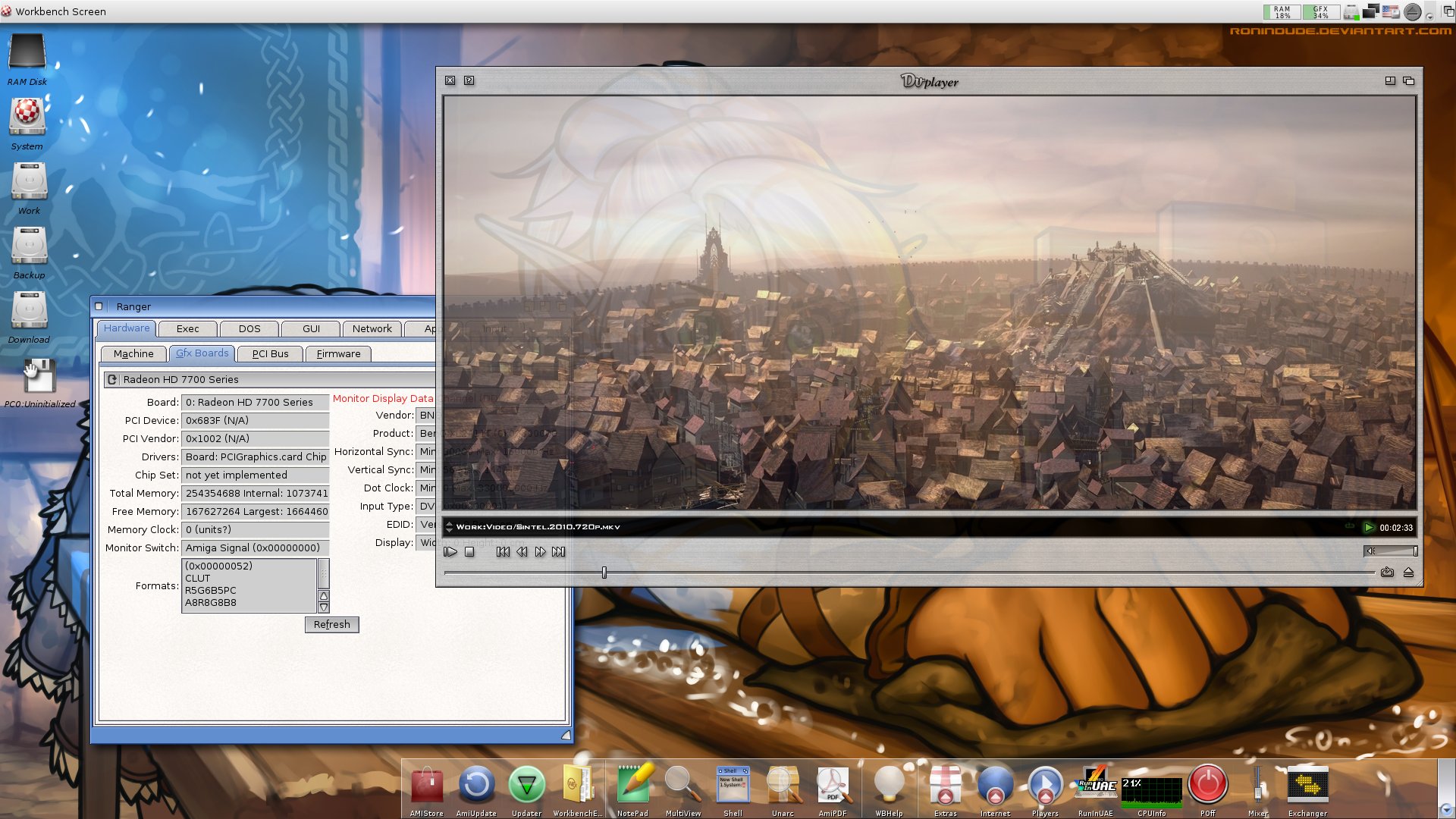
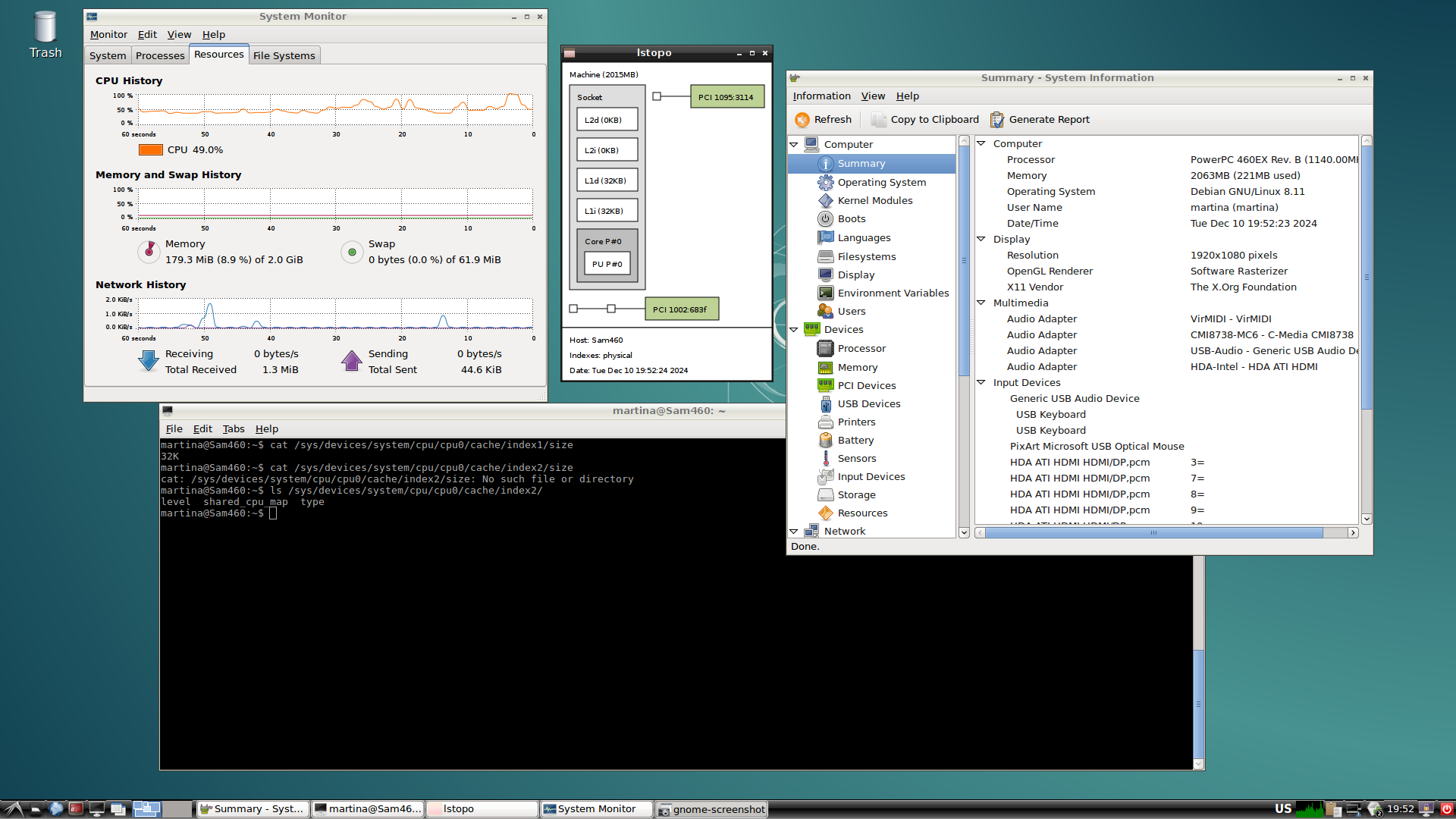
Linux is without 3D hardware acceleration on these graphics cards, it only has the Radeon DRM framebuffer and Mesa 3D software. This framebuffer is a shadow, what we call a double buffer. We can't think about 3D games or HD video, but for normal work and office, the LXDE desktop is fast enough.
4.3 MorphOS ( 2D ) + AmigaOS ( 2D, legacy W3D ) + linux ( drmfb )


This is the best solution if you want to have MorphOS and AmigaOS at the same time. The fact that MorphOS has only 2D acceleration doesn't bother us so much - enough games are ported using SDL2.
Where you lose more quality is AmigaOS, you won't be able to play HD video and you won't be able to use the Warp3D Nova apps, which are just the state of the art. However, older MiniGL and Warp3D applications will run fast enough using WaZp3D + HW compositing.
Even though these cards are normally fully supported by powerpc big-endian linux, the radeon driver generates a ring_test error in Sam460LE. The error could not be fixed, so we only have the Radeon DRM framebuffer and Mesa 3D software working for all cards in Linux, just like the Southern Islands cards.
4.4 MorphOS ( 3D ) + AmigaOS ( 2D, legacy W3D ) + linux ( drmfb )

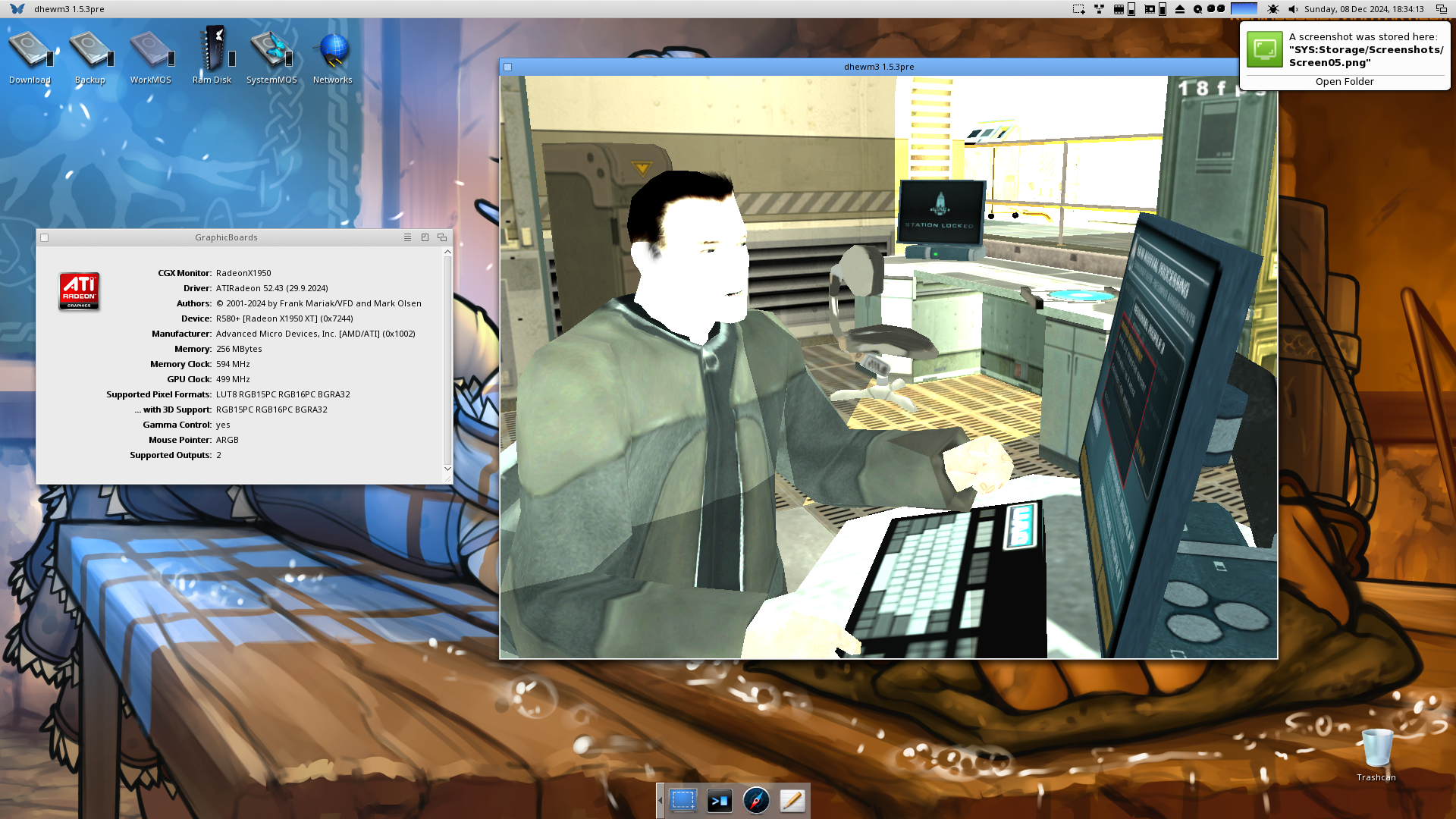
Use this option if you have a favorite TinyGL application that you can't be without. However, I would prefer to wait until bigfoot finishes upgrading the MorphOS 3D drivers to TeraScale 2. Then we would have 3D support in MorphOS for the cards mentioned in 4.3.
4.5 linux ( drmfb ) + AmigaOS ( 2D, legacy W3D )

I do mention this option, but probably few people will use it. Under standard circumstances, this would be the option with the fastest fully supported card for linux. But since neither 3D nor VA acceleration works on the Sam460 with Linux, these graphics cards have no advantage over the Southern Island cards.
5. Speed of applications
You must be wondering how the Sam460LE is doing with application speed. Of course compared to the AmigaOne X1000, X5000 or Powermac G5 it is slow. I won't reveal the comparison with the A1222+ yet, that will be in a future article. But compared to other NG Amigas with G3 and G4 processors it stands up pretty well.
Where Sam460 is slower are CPU intensive applications like Lame, Blender, and MPlayer. It is also slower when browsing the web.
On the other hand, the speed of RAM, video, disk and network is higher.
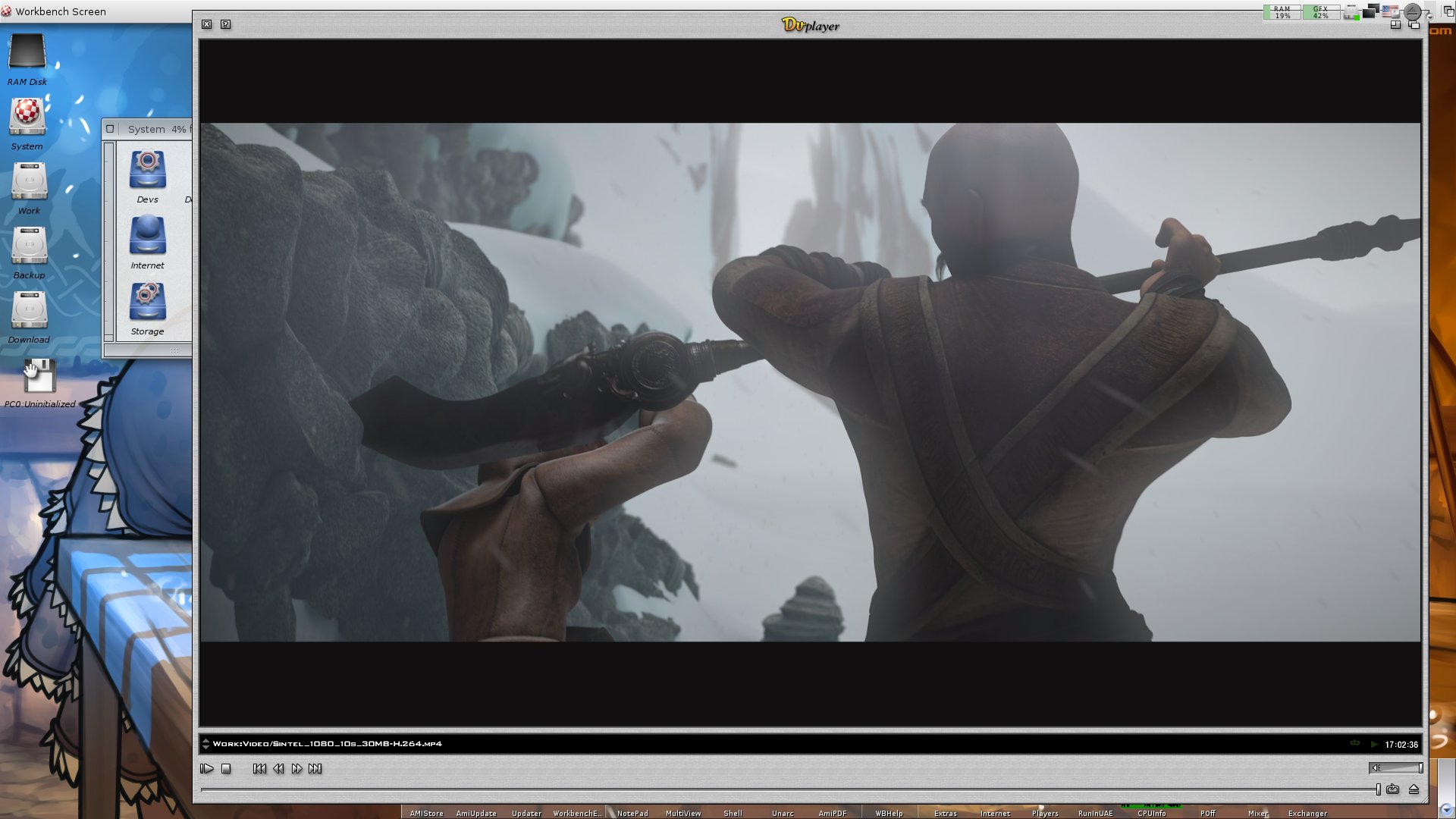
MPlayer is slow on the CPU, but Sam460 has functional video acceleration on the graphics card in AmigaOS. So using DVPlayer it can also handle H.264 FullHD videos, which only the A1222+ and then big computers like the X1000, X5000 and Powermac G5 can do. Not even my overclocked Mac Mini G4 / 1.83 GHz can do this.
The classic Amiga emulation ( E-UAE ) is fast enough: in AmigaOS4 the speed corresponds to a 68040 / 45 MHz CPU and in MorphOS 68040 / 50 MHz. So it is sufficient for games with a large margin.
The PC emulation ( DOSBox ) is already slower in AmigaOS: i80386 / 40 MHz and is not suitable for demanding DOS games ( like my favourite Master of Magic ). MorphOS, however, handles PC emulation better - i80486 / 30 MHz and demanding DOS games are snappy here.
Office is fast enough on Linux, but working with Gimp, for example, is already uncomfortable.
Here's a comparison of some challenging AmigaOS games and the Sam460 stands up very well:

Sam460 benefits from having a modern PCIe graphics card and in games Tower57 and WingsBattlefield performance catches up or surpasses not only Pegasos 2 / 1.33 GHz and AmigaOne XE / 1.4 GHz but even Mac Mini G4 / 1.83 GHz ( not in the chart, my overclocked Mini here reaches 46 FPS respectively 43 FPS ).
Demanding 3D FPS like RTCW or DHEWM3 are slow on Sam460, but modern Spencer or HCraft are perfectly playable.
Similarly for MorphOS: Wyrmsum is slow, Wesnoth is perfectly playable. And Doom 3 is much faster with MorphOS ( 20.1 FPS ) so you can play it, but at low quality - see Figure 4.4.
For the speed of graphics applications in AmigaOS, it is also important to know that GART is not yet working due to the not fully consistent L2 cache in RadeonRX and RadeonHD drivers. If this can be resolved in future versions of the drivers, Sam460 will get an additional speed bonus.
6. Upgrade and expansion options
As I mentioned, the Sam460 ready to use, i.e. equipped with HDD controller, graphics and sound card has all expansion slots full. So there is no room for possible future expansion at first glance. You can just replace the components with newer and more powerful ones.
But Sam460 can actually be extended quite a bit. In fact, you can fit a PCIe x1 slot with a PCIe switch. Max Tretene (m3x) from ACube tested a switch with ASMedia ASM1184e chip. With it we can then plug up to four PCIe x1 cards into the PCIe x1 slot. Of course, it's a switch, so all devices then share one PCIe line. So it's not exactly a suitable solution for plugging in another graphics card or NVMe, but for other cases it doesn't limit us too much.
If you have the Sam460ex version, you can use the AC97 on the SM502 chip for sound and save the sound card, leaving one slot free. For Sam460cr/LE types you do not have this option. But I accept that the decision not to fit the SM502 chip in later versions was a sensible one. Video is of little comfort here for the desktop, and having it there just for audio is unnecessarily expensive.
Another way to save a slot is to use a USB audio device like this one. However, the drivers are only for MorphOS and Linux.

6.1 Overclocking and tuning
When it comes to overclocking, virtually the same thing I wrote about its predecessors applies to the Sam 460. It is already perfectly tuned from the factory. So you can't overclock anything yourself.
And if we look at the serial output of my Sam's U-Boot, we find this:
CPU: AMCC PowerPC 460EX Rev. B at 1140 MHz (PLB=228 OPB=114 EBC=114)
...
DRAM: 2 GiB (ECC not enabled, 456 MHz, CL4)
The processor frequency is 1140 MHz ( nominally 1000 MHz ), the Processor Local Bus ( PLB ) is clocked at 228 MHz ( nominally 200 MHz ) and the DDR2 memory is clocked at 456 MHZ ( nominally 400 MHz ). So we already have higher frequencies.
In U-Boot, you can also turn on boost RAM, which brings about 5% of memory speed, but causes instability in some memory modules. You have to try it.
So you can see that ACube really played around with Sam460LE, they improved the CPU performance quite a bit and there was nothing left for us to improve except the choice of graphics card.
6.2 More memory ? Maybe.
Sam460 comes with a maximum of 2 GB DDR2 RAM. My 2 GB module has 2 ranks ( 2R ). And since the processor can address up to 8 GB ( 4R ) of physical memory, it could theoretically use a 4 GB ( 2R ) module. So maybe just a firmware change would be enough. Unlike other computers, this is not impossible - ACube is still developing the firmware. Memory above 2 GB will be used by Linux and some AmigaOS applications.
Note: I have tried one 4 GB ( 2R ) module and it does not work.
7. Conclusion
Yes of course, if you like to play challenging FPS games or model on Blender Sam460LE is not for you. But its advantages are elsewhere. It's the kind of worker that doesn't excel at anything, but still gets more work done overall than others.
The Sam460 outperforms the first-generation Amiga NGs with a modern graphics card with more video memory and video acceleration, the AmigaOne X1000 with MorphOS install option, and the X5000 with price.
The Sam460LE is simply a very nicely tuned computer for everyday work, classic Amiga emulation and moderately demanding games. You can choose your operating system - MorphOS and AmigaOS for the NG Amiga feel, AmigaOS for FullHD video or Linux for Office and advanced networking applications.
Importantly, the Sam460LE is one of the few NG Amigas you can buy new today, which is not insignificant with our twenty year old machines.
And as a great, if at first sight invisible, advantage I have to mention that ACube is still very active in the Amiga world and you can always find advice on the forums. The firmware of the computer is still being developed, so even modern components that did not exist at the time of its creation are now compatible with Sam460.
Overall I am very satisfied with the Sam460LE. For myself, I ended up choosing the configuration from paragraph 4.3 ( for all three operating systems ) and I also registered MorphOS.
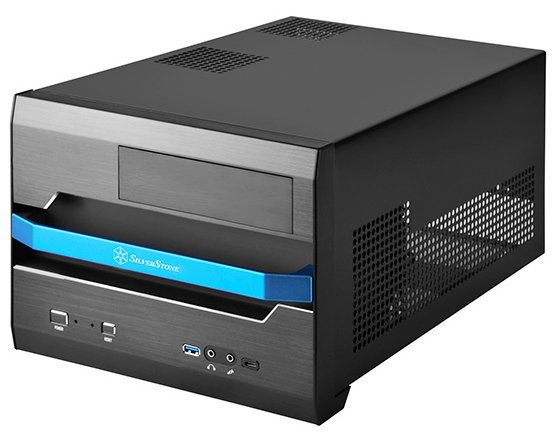
2025 Addendum
On April 8, ACube released a new version of U-Boot 2015.d. This version can boot directly from an NVME or SATA 2 controller and also allows additional tweaking of DDR2 memory.
So you can see how important it is when a manufacturer supports their product consistently. It's a pity that this can't be said about, for example, the X1000.
Images used:
- ACube logo, Sam460le logo, Sam460le motherboard from acube-systems.biz
- Radeon X1300 screenshot courtesy of Hans de Ruyter from hdrlab.org.nz
- Sugo SG12 from silverstonetek.com
